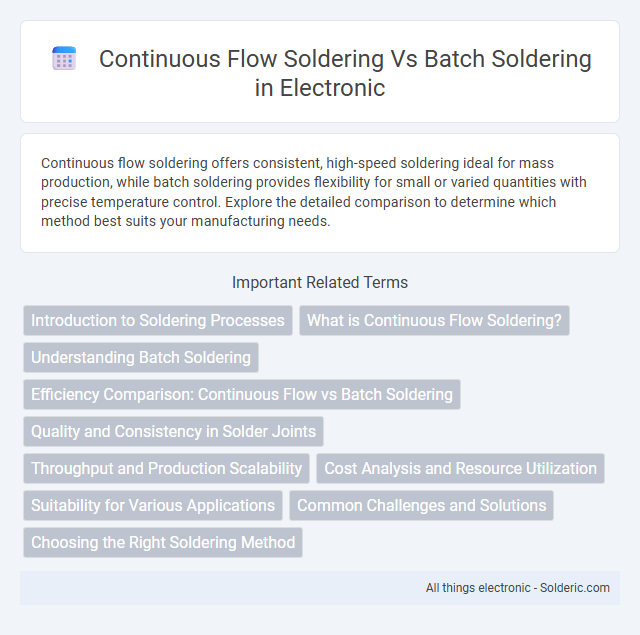Continuous flow soldering offers consistent, high-speed soldering ideal for mass production, while batch soldering provides flexibility for small or varied quantities with precise temperature control. Explore the detailed comparison to determine which method best suits your manufacturing needs.
Comparison Table
| Aspect | Continuous Flow Soldering | Batch Soldering |
|---|---|---|
| Process Type | Automated, inline soldering | Manual or semi-automated, soldering group of boards |
| Throughput | High, suited for mass production | Low to medium, suited for small to medium batches |
| Consistency | High repeatability and uniform solder joints | Variable, depends on operator skill and setup |
| Setup Time | Long initial setup, minimal changeover time | Short setup, longer changeover between batches |
| Flexibility | Less flexible, optimized for specific board types | More flexible with varying board sizes and types |
| Cost Efficiency | Cost-effective for high volume production | Cost-effective for low volume or prototype runs |
| Typical Applications | Mass-produced electronics, automotive, consumer goods | Prototyping, small-to-medium batches, repair work |
Introduction to Soldering Processes
Continuous flow soldering uses a conveyor system to pass circuit boards through a molten solder wave, enabling high-speed, consistent solder joints ideal for mass production. Batch soldering involves manually or mechanically dipping individual boards into solder, suitable for small runs or prototypes but with slower throughput and greater variability. Your choice depends on production volume and precision needs, as continuous flow offers efficiency and uniformity while batch provides flexibility and lower initial cost.
What is Continuous Flow Soldering?
Continuous flow soldering is a wave soldering technique where printed circuit boards (PCBs) move on a conveyor through a molten solder wave, enabling rapid and consistent solder joints. This method supports high-volume production with uniform temperature control and reduced thermal stress on electronic components. It contrasts with batch soldering by offering continuous processing, which increases throughput and enhances assembly reliability in large-scale manufacturing environments.
Understanding Batch Soldering
Batch soldering involves processing multiple circuit boards simultaneously in a furnace, allowing precise temperature control and uniform heat distribution for complex assemblies. This method is ideal for small to medium production runs, offering flexibility and easier inspection between batches. Compared to continuous flow soldering, batch soldering provides better control over thermal profiles, reducing the risk of component damage in sensitive electronics.
Efficiency Comparison: Continuous Flow vs Batch Soldering
Continuous flow soldering offers superior efficiency compared to batch soldering by enabling uninterrupted processing of printed circuit boards (PCBs), which reduces cycle time and increases throughput. Batch soldering involves processing multiple PCBs simultaneously in discrete stages, causing idle periods and lower overall equipment utilization. Continuous flow systems optimize temperature profiles and minimize thermal stress, resulting in consistent solder joint quality and reduced rework.
Quality and Consistency in Solder Joints
Continuous flow soldering offers superior quality and consistency in solder joints due to its controlled, automated process that maintains precise temperature profiles and uniform solder application. Batch soldering, while flexible for smaller production runs, often results in variability in joint quality caused by inconsistent heating and manual handling. Your production lines benefit from continuous flow soldering by reducing defects and ensuring reliable, repeatable solder joint integrity across high-volume manufacturing.
Throughput and Production Scalability
Continuous flow soldering provides higher throughput and better production scalability by enabling constant processing of PCBs with minimal downtime. Batch soldering processes PCBs in fixed quantities, limiting throughput and requiring more time to scale up production volumes. Your manufacturing efficiency improves significantly with continuous flow systems designed for seamless integration and rapid output.
Cost Analysis and Resource Utilization
Continuous flow soldering reduces labor costs and minimizes material wastage by maintaining a steady, automated production line, resulting in higher throughput and lower per-unit expenses compared to batch soldering. Batch soldering incurs higher energy consumption and increased setup times per batch, leading to elevated operational costs and less efficient resource utilization. Investing in continuous flow systems maximizes equipment uptime and streamlines thermal energy usage, optimizing overall manufacturing cost efficiency.
Suitability for Various Applications
Continuous flow soldering suits large-scale electronics manufacturing requiring consistent, high-speed processing, ideal for printed circuit boards in consumer electronics and automotive industries. Batch soldering excels in low to medium volume production, prototyping, and repair work, offering flexibility for diverse component types and complex assemblies. Each method's suitability depends on production volume, component sensitivity, and the need for process control precision.
Common Challenges and Solutions
Continuous flow soldering often faces challenges such as maintaining consistent temperature profiles and preventing solder bridging, addressed by precise conveyor speed control and optimized flux application. Batch soldering struggles with uneven heat distribution and longer cycle times, mitigated by improved fixture design and enhanced thermal profiling techniques. Your manufacturing efficiency benefits from selecting the appropriate soldering method tailored to your specific production volume and quality requirements.
Choosing the Right Soldering Method
Choosing the right soldering method depends on your production volume, product complexity, and quality requirements. Continuous flow soldering excels in high-volume manufacturing with consistent thermal profiles ensuring uniform solder joints, while batch soldering offers flexibility and lower initial costs suitable for small-scale or prototype runs. Evaluating your specific needs for throughput, thermal control, and budget will help determine the optimal approach for your soldering process.
continuous flow soldering vs batch soldering Infographic

 solderic.com
solderic.com